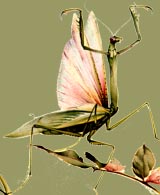 |
 back back   next next
Insects and Biodiversity
Insects and People
Insect Characteristics
|
|




INSECTS AND BIODIVERSITY
INSECTS AND FLOWERING PLANTS
Pollen transfer and more
Insects and Flowering Plants
With the advent of angiosperms (flowering plants) over 100 million years ago, a unique relationship began between plants and certain insects especially bees. Angiosperms and insects have co-evolved, insects affecting the evolution of the plants and vice versa. Insects benefit plants in that they provide a reliable means of pollen transfer; flower structure has become very diverse with the adaptation to insect pollination. In turn, the flowers provide food for the insects.
A Focus on Bees
Bees visit flowers to obtain either nectar or pollen which serve as a food source for both the adult bees and their larvae. Relationships between certain groups of flowers and bees are constant. Sometimes they lead to modifications in both the flowers and the bees. For example, the time of day when a flower opens may correlate with the time a bee feeds on it. The mouthparts of bees also may gradually elongate so that they can feed on tubular flowers. Thus, the bees provide an efficient mechanism of pollination and the flowers, a constant food source for the bees.

Fig A is what we see. Fig B is what a bee sees.
Many of the flowers visited by bees are yellow. The pigments found in these flowers reflect both in the visible spectrum to humans, and in the ultraviolet range invisible to humans. The mix of these two ranges results in a distinctive colour called "bee's purple". To a bee, some flowers appear as though there is a central bull's eye. This guides the bee to the area where the nectar or pollen can be collected.
 Back to top
Back to top
|